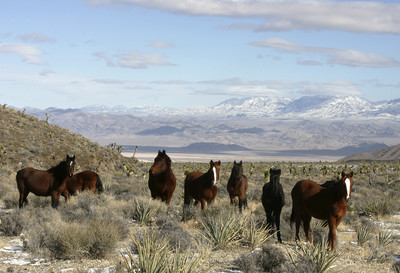Wild horse deaths studied
Bureau of Land Management officials in Las Vegas are reviewing a draft report on soil and water samples collected in February as part of a probe to pinpoint the source of nitrate contamination that killed 71 wild horses last year near a watering hole at the Tonopah Test Range.
Because the data is preliminary, the BLM's staff declined to release the 48-page document.
Kirsten Cannon, a bureau spokeswoman, said the Desert Research Institute is required under an $80,630 contract to submit a final, releasable version of the report by July 2.
She said Tuesday that the preliminary report didn't include data on nitrogen isotopes. The data and analysis of such isotopes, which will be part of the final report, are important to determining whether the ingredient that caused the horse deaths was man-made or naturally occurring.
Former workers at the Tonopah Test Range, 210 miles northwest of Las Vegas, have said that tanker trucks filled with urea de-icing solutions, high in nitrogen content, routinely were flushed near a usually dry lake bed where the horses occasionally drank water.
They have said that large quantities of de-icing compounds routinely were used for years by contractors and the Air Force during cold weather for aircraft and airfield operations at the remote test range.
In August, the BLM concluded that nitrate toxicity was the most probable cause of death of the horses. Their carcasses were found in July along a dry lake bed in the vicinity of a watering hole.
High levels of nitrates that were 66 times in excess of safe drinking standards for humans and 30 times more than the acceptable levels for livestock were found in some water samples taken from a pond in the area.
BLM records confirm that a de-icing compound caused a similar die-off of 61 horses at the Tonopah Test Range in 1988.
Contact reporter Keith Rogers at krogers@reviewjournal.com or 702-383-0308.

















